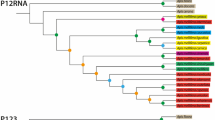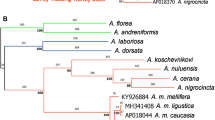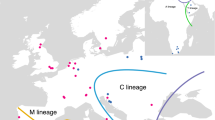Abstract
IN the Neotropics, introduced European honey bees (Apis mellifera L.)1,2 have been largely supplanted by bees descended from an African race, A. m. scutellata Lepetier, which were introduced into Brazil in the 1950s. Recent restriction enzyme analyses indicate that mitochondrial DNA in some neotropical populations is almost entirely of African origin3,4, and these data have been cited as evidence for asymmetrical gene flow between African- and European-derived populations3,4. Evaluation of the nature of hybridization in the Neotropics is, however, confounded by possible population size advantages for the African-derived group5–7. As an alternative approach, genetic interactions can be studied in transition areas between zones ecologically and climatically adaptive for both racial groups. We describe here results of a survey transecting regions populated by African- and European-derived honey bees in Argentina. Mitochondrial DNA, morphological and isoenzyme analyses show that substantial hybridization occurs between the two racial groups.
This is a preview of subscription content, access via your institution
Access options
Subscribe to this journal
Receive 51 print issues and online access
$199.00 per year
only $3.90 per issue
Buy this article
- Purchase on Springer Link
- Instant access to full article PDF
Prices may be subject to local taxes which are calculated during checkout
Similar content being viewed by others
References
Ruttner, F. Biogeography and Taxonomy of Honey Bees (Springer, Berlin, 1988).
Sheppard, W. S. Am. Bee. J. 129, 617–619, 664–667 (1989).
Smith, D. R., Brown, W. M. & Taylor, O. R. Nature 339, 213–215 (1989).
Hall, G. H. & Muralidharan, K. Nature 339, 211–213 (1989).
Taylor, O. R. Bull. ent. Soc. Am. 31, 14–24 (1985).
Page, R. E. Jr Nature 339, 181–182 (1989).
Rinderer, T. E. in Africanized Honey Bees and Bee Mites (eds Needham, G. R., Page, R. E. Jr, Delfinado-Baker, M. & Bowman, C.) 13–28 (Ellis Horwood, Chichester, 1988).
Daly, H. & Balling, S. S. J. Kans. Entomol. Soc. 51, 857–869 (1978).
Kerr, W. E. & Bueno, D. Evolution 24, 145–148 (1970).
Rinderer, T. E., Hellmich, R. L. III. Danka, R. G. & Collins, A. M. Science 228, 1119–1121 (1985).
Roubik, D. W., Ecology 61, 836–845 (1980).
Sheppard, W. S. & Huettel, M. D. in Africanized Honey Bees and Bee Mites (eds Needham, G. R., Page, R. E. Jr, Delfinado-Baker, M. & Bowman, C.) 281–286 (Ellis Horwood, Chichester, 1988).
Sylvester, H. A. J. Apic. Res. 21, 93–97 (1982).
Lobo, J. A., Del Lama, M. A. & Mestriner, M. A. Evolution 43, 794–802 (1989).
Del Lama, M. A., Lobo, J. A., Soares, A. E. E. & Del Lama, S. N. Apidologie 21, 271–280 (1990).
Ruttner, F. in The Hive and the Honey Bee (eds Dadant & Sons) 19–38 (Dadant, Hamilton, Illinois, 1975).
Kerr, W. E., de Leon del Rio, S. & Barrionuevo, M. D. Am. Bee J. 122, 196–197 (1982).
Dietz, A. & Krell, R. Apidologie 16, 99–108 (1985).
Barton, N. H. & Hewitt, G. M. A. Rev. ecol. Syst. 16, 113–148 (1985).
Michener, C. D. A. Rev. Ent. 20, 339–416 (1975).
Taylor, O. R. in Africanized Honey Bees and Bee Mites (eds Needham, G. R., Page, R. E. Jr, Delfinado-Baker, M. & Bowman, C.) 29–41 (Ellis Horwood, Chichester, 1988).
Winston, M. L., Otis, G. W. & Taylor, O. R. Jr J. Apic. Res. 18, 85–94 (1979).
Hall, G. H. Genetics 125, 611–621 (1990).
Powell, J. R. Proc. natn. Acad. Sci. U.S.A. 80, 492–495 (1983).
Marchant, A. D., Arnold, M. L. & Wilkinson, P. Heredity 61, 321–328 (1988).
Hewitt, G. M. Trends Ecol. Evol. 3, 158–167 (1988).
Sheppard, W. S. Ann. Ent. Soc. Am. 81, 886–889 (1988).
Sheppard, W. S. & McPheron, B. A. in Diversity in Apis (ed. Smith, D. R.) (Westview, Colorado, in the press).
Sheppard, W. S. & Huettel, M. D. Am. Bee J. 127, 851 (1987).
Rinderer, T. E. et al. Ann. Ent. Soc. Am. 83, 346–351 (1990).
Author information
Authors and Affiliations
Rights and permissions
About this article
Cite this article
Sheppard, W., Rinderer, T., Mazzoli, J. et al. Gene flow between African- and European-derived honey bee populations in Argentina. Nature 349, 782–784 (1991). https://doi.org/10.1038/349782a0
Received:
Accepted:
Issue Date:
DOI: https://doi.org/10.1038/349782a0
This article is cited by
-
Current genetic diversity of managed and commercially produced Apis mellifera colonies in Argentina inferred by wing geometric morphometrics and COI-COII mtDNA locus
Apidologie (2022)
-
Wide genetic diversity in Old World honey bees threaten by introgression
Apidologie (2021)
-
Influence of reproductive biology on establishment capacity in introduced Hymenoptera species
Biological Invasions (2021)
-
Genetic characteristics of the Iranian honey bee, Apis mellifera meda, based on mitochondrial genes of ND4, ND4L and ND6 and their internal transcribed spacers
Insectes Sociaux (2020)
-
The genetic consequences of the anthropogenic movement of social bees
Insectes Sociaux (2016)
Comments
By submitting a comment you agree to abide by our Terms and Community Guidelines. If you find something abusive or that does not comply with our terms or guidelines please flag it as inappropriate.



